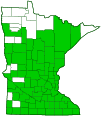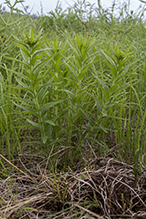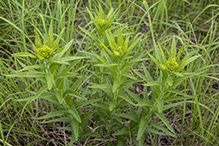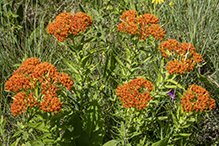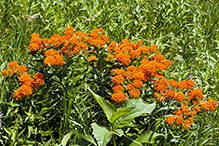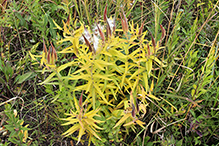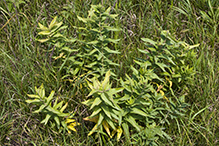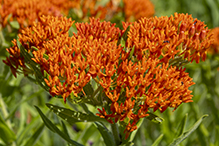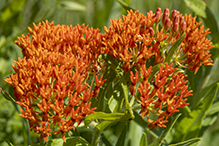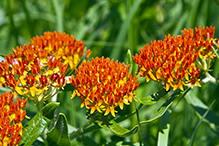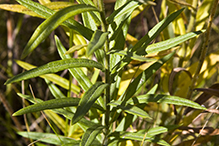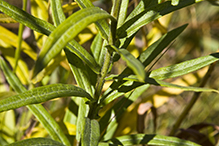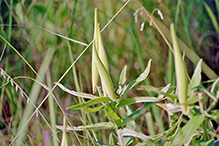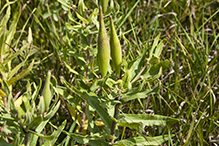butterfly weed
(Asclepias tuberosa ssp. interior)
Conservation • Description • Habitat • Ecology • Use • Distribution • Taxonomy
|
|
|||||||||||||
Description |
Butterfly weed is a 12″ to 36″ tall, weakly erect, perennial herb. A single stem rises from a large, deep, thick, knobby, woody taproot. As the plant matures, it sends up multiple lateral stems from the taproot (tillers). Mature plants, with many flowering branches and multiple lateral tillers, appear bushy, round in form. The leaves and stems contain a watery, not milky, juice. The stems are erect or ascending, stout, leafy, and densely covered with long, soft hairs. They are unbranched below and often form multiple branches near the top. The leaves are alternate except just below the inflorescence, where they are opposite. They are numerous and crowded. They are 2″ to 4″ long, ¼″ to 1″ wide, narrowly lance-shaped, widest below the middle, and tapering gradually to the tip. They are attached to the stem on short, less that ⅛″ long, leaf stalks. The margins are untoothed and may be slightly rolled under. The upper surface is shiny and slightly hairy. The lower surface is more hairy and a lighter shade of green. The inflorescence is 1 to several erect, umbrella-shaped clusters (umbels) at the end of the stem and rising from the upper leaf axils. The clusters are spherical, 2″ to 4″ in diameter, and are on a short stalk or no stalk at all. They typically have 6 to 25 flowers. The structure of the typical milkweed flower is unique and instantly recognizable. There are 5 petals bent backward at the base and hanging downward. Subtending the petals are 5 much shorter, light green, lance-shaped sepals. There are 5 stamens. Formed from the filament of each stamen is a petal-like appendage. The appendage consists of a tubular hood surrounding an awl-shaped horn in the center of the hood. The stamens and the stigma are fused together into a crown-like structure (gynostegium). Each stigma has a long slit designed to catch the legs of a pollinating insect. A small, dark, sticky gland above this slit is attached to pollen sacs from adjacent anthers. These glands are designed to break off as an insect pulls its leg free of the slit, and remain attached to the insects leg. The flowers are pollinated by larger insects strong enough to lift off with the pollen sacs attached. Smaller insects are caught in a death trap or leave behind their detached legs. The flowers of this plant are shaped like the typical milkweed flower. They are ⅜″ to ⅔″ tall and are attached on flower stalks that are up to ¾″ long. The petals are pale orange to dark reddish orange. They bend backward at the base, hang downward, then curl upward near the tip. They are separated from the hoods by a distinct column. The hoods are the same color as the petals. The horns are shorter than the hoods. They project from the hoods and are curved inwards. The flowers are long-lasting and not fragrant. The fruit is a narrow, spindle-shaped pod. It is 3″ to 5″ long and ½″ to ¾″ wide. It is held erect on a downward-curved stalk. It opens on one side exposing the seeds to spreading by the wind. The seeds have a tuft of white hairs at the tip. |
Height |
12″ to 36″ |
Flower Color |
Pale orange to dark reddish orange |
Similar Species |
This is the only milkweed in Minnesota with orange flowers. |
Habitat |
Dry to moderate moisture. Prairies, upland woods. Full sun. |
Ecology |
Flowering |
July to September |
Faunal Associations |
Milkweeds are the only plants that Monarchs lay their eggs on. The eggs are laid on the underside of healthy young leaves. |
Toxicity |
This and other milkweeds contain cardiac glycosides and may be poisonous to both humans and livestock. |
Pests and Diseases |
|
Use |
|
Distribution |
||
|
Sources |
|
Nativity |
||
Native |
||
Occurrence |
||
|
||
Taxonomy |
|
Kingdom |
|
Division |
Tracheophyta (Vascular Plants) |
Subdivision |
Spermatophytina (Seed Plants) |
Class |
|
Order |
Gentianales (Gentians, Dogbanes, Madders, and Allies) |
Family |
Apocynaceae (dogbane) |
Subfamily |
Asclepiadoideae (milkweeds) |
Tribe |
Asclepiadeae |
Subtribe |
Asclepiadinae |
Genus |
|
Species |
Asclepias tuberosa (butterfly milkweed) |
Subordinate Taxa |
|
|
|
Synonyms |
|
Asclepias tuberosa f. bicolor Asclepias tuberosa f. flavescens Asclepias tuberosa f. lutea Asclepias tuberosa ssp. terminalis Asclepias tuberosa var. flexuosa Asclepias tuberosa var. interior |
|
Common Names |
|
butterfly milkweed butterfly weed butterfly-weed Canada root chiegerflower chigger weed midwestern butterfly-weed orange milkweed pleurisy root |
|
Glossary
Axil
The upper angle where the leaf stalk meets the stem.
Gynostegium
A crown-like structure of plants of the genus Asclepias formed by the fusion of the anthers with the stigmas.
Linear
Long, straight, and narrow, with more or less parallel sides, like a blade of grass.
Tiller
In forbs, an aerial, more or less erect shoot arising from the base of a plant.
Umbel
A flat-topped or convex, umbrella-shaped cluster of flowers or buds arising from more or less a single point.
Visitor Photos |
||
Share your photo of this plant. |
||
This button not working for you? |
||
Nancy Falkum |
||
 |
||
Butterfly weed Asclapias tuberosa At TNC KWD Cox Unit |
||
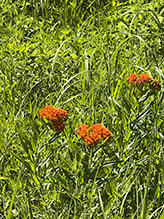 |
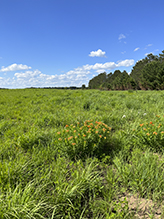 |
|
Alfredo Colon |
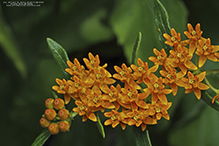 |
Gerry Garcia |
 |
Asclepias tuberosa On the same hike around Normandale Lake this morning, this pretty, coral-colored Butterfly-weed was definitely open for business, but we saw no Monarchs or any other customers. |
Wayne Rasmussen |
 |
Male lemon cuckoo bumble bee on butterfly milkweed |
MinnesotaSeasons.com Photos |
||
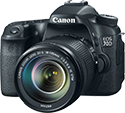
Slideshows |
Asclepias tuberosa (Butterfly Milkweed) |
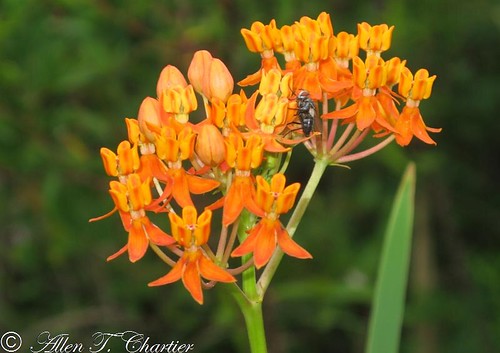
|
Asclepias tuberosa BUTTERFLY MILKWEED |
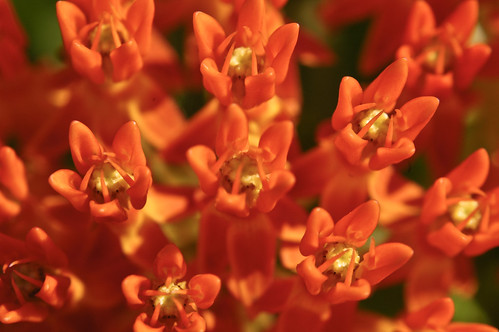
|
A. tuberosa |
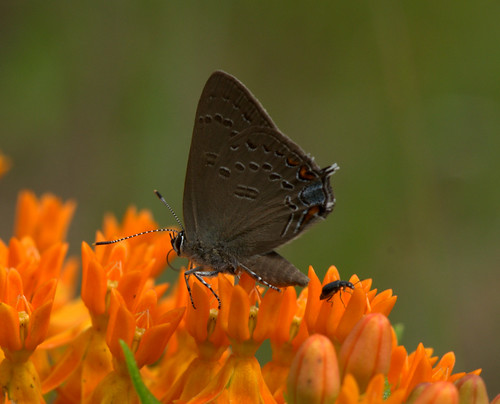
|
About
Butterfly Milkweed |
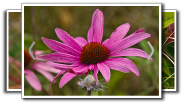
Visitor Videos |
||
Share your video of this plant. |
||
This button not working for you? |
||
|
Other Videos |
||
Butterfly Weed - a world of butterflies |
About
Uploaded on Oct 3, 2011 Butterfly weed attracts many species of butterfly to its orange flowers. Caterpillars are also found on the plant |
Asclepias tuberosa L. Butterfly Milkweed |
About
Uploaded on Jun 6, 2010 Asclepias tuberosa is a species of milkweed native to eastern North America. It is a perennial plant growing to 0.6-2 m (1 -2 feet) tall, with clustered orange or yellow flowers from early summer to early fall. The leaves are spirally arranged, lanceolate, 5-12 cm long and 2-3 cm broad. This plant favors dry, sand or gravel soil, but has also been reported on stream margins. It requires full sun. It is commonly known as Butterfly Weed because of the butterflies that are attracted to the plant by its color and its copious production of nectar. It is also the larval food plant of the Queen and Monarch butterflies. Butterfly Weed grows to be 1-3 feet long. Extracts in herbalism and by Native Americans were used as an expectorant for wet coughs and other pulmonary ailments. Use of the herb is contraindicated in pregnancy, during lactation or with infants due to the small amount of cardiac glycosides.[1] |
Butterfly Weed video ( Asclepias tuberosa) |
About
Published on Jun 26, 2012 Butterfly Weed ( Asclepias tuberosa) |
Nelson 2 Asclepias tuberosa.MP4 |
About
Uploaded on Nov 2, 2010 New England Wild Flower Society Horticulture Intern Nelson discusses Asclepias tuberosa (buttterfly-weed) in Garden in the Woods' New England Garden of Rare and Endangered Plants |
Minnesota Native Plant - Butterfly Weed (Asclepias Tuberosa) |
About
Published on Jul 7, 2013 This video shows the MN native plant, Butterfly Weed (Asclepias Tuberosa). A great plant for the native garden and one of the only true orange bloomers in the Minnesota native garden. |

Visitor Sightings |
||
Report a sighting of this plant. |
||
This button not working for you? |
||
Nancy Falkum |
Location: Oronoco Prairie SNA |
 |
| Nancy Falkum 6/26/2022 |
Location: Weaver Dunes Preserve, Cox Unit Butterfly weed Asclapias tuberosa At TNC KWD Cox Unit |
 |
| Alfredo Colon 8/2/2019 |
Location: Woodbury, Minnesota |
 |
| Wayne Rasmussen 7/17/2016 |
Location: Joy Park |
 |
MinnesotaSeasons.com Sightings |
||
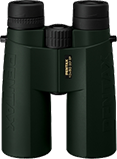
|
Created: 10/7/2005 Last Updated: © MinnesotaSeasons.com. All rights reserved. |

